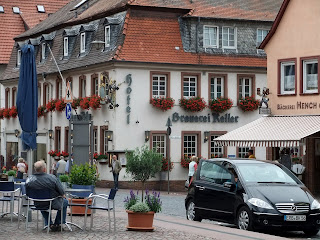URBAN RENEWAL AND THE GRAVEYARD OF HISTORY
HE SAYS:
Our river boat glides down the Main River as we watch the
quiet, green shore line with its overgrown vegetation, occasionally littered
with tourist rec vehicles in camp sites. There is a gentle mist falling which
will become a downpour. Now, today, the river is, literally, quiet as a grave
yard. And the metaphor is all too appropriate as I think about what I have
seen.
Some random retrospective and prospective thoughts….
O The Jewish community in Cologne, which we visited two days
ago, was reputed to be the oldest in
Europe with a population of about 30, 000 in 1933; at the war’s end the
population was only 3, 000. Today, with the influx of Eastern European
immigrants, it has a population of 8, 000 and boasts a new (Conservative)
synagogue.
O As we left the boat to board our buses for our tour of Koblenz
there was a tall, guff gentleman behind me who growled, “Why are we visiting Koblenz?
I thought we bombed it flat.” There is
an unarticulated, but real low-key tension between the nominally apolitical
tourist experience of most, and the cloud of memory of others, and the historical
amnesia of the locals.
O We leave for our tour this morning to Wurzburg, a
colorful, small-large town with a mixed economy; however, it is best known for
being a university town. The local Franconia white wine was nice, but the town
is otherwise non-descript, being a mixture of old timbered houses and post-war
modern archtecture. One of our German tour guides says that the town was spared
saturation bombing until the end of WW II when it was fire bombed. The woman
next to me whispers, “What are they complaining about? They got free urban renewal.” This tension is
glossed over with a benign smile.
O We visited Miltenberg, in Bavaria, yesterday. Our guide,
Bridgette, was superlative – knowledgeable, bright and enthusiastic. She knew
her local history and had a feel for small town (10, 000 pop) life and politics.
She bragged that the mayors in Bavaria, who evidently have a good deal of
political power, in the 1930s rejected the lured of National Socialism (Nazis).
But even she, who is strongly anti-Nazi, didn’t know that it was the Bavarian
Peasants’ Party that threw their electoral support to Hitler so that he could
be elected.
After the formal tour she also took us, at our request, to
the local Jewish cemetery. Interestingly, it was desanctified in 1904 (yup)
after the entire Jewish community left for some reason; it was never used
again. We contemplated this experience over a beer in Germany’s oldest beer
hall.
At the beer hall another person who knew the local scene told us a blood curdling story. A few years ago her then teenaged daughter found out that there was a group of students and townspeople getting together for a meeting, but she wasn’t invited because she was of a mixed marriage, and wasn’t considered to be fully German. As it turns out, this group of students, adult townspeople and grandchildren of local Nazis had dug up Nazi paraphernalia that had been buried after the war and were now having Nazi marching drills in a cellar. As well, there had been a large and unchallenged neo-Nazi demo in this town only a few years ago.
This is the ugly underbelly of the new Germany.
Notwithstanding denazification, and saccharine platitudes, Germany still suffers
from historical amnesia, as do the Austrians and the Japanese. The recent historiography on German fascism has
emphasised how the Nazi movement took root in small towns and tries to answer the
questions: Why did people support the Nazis? and, why did people follow orders?
The most cogent study in this genre is Ordinary People by Browning. And what this study shows, simply, is that
ordinary people did unspeakable things in the name of security, employment,
community, and ideology. But historical amnesia leads to the graveyard, both
for victims and victors.
My lengthy op-ed piece in The Ottawa Citizen (Aug 28, 2011)
demonstrates that genocide is an old as human history, and that no one group,
religion or ethnic group has a monopoly on misery or being victims; we should
honour all of the victims of genocide throughout history. Promo Levy, the
famous Italian writer and holocaust survivor, wrote a New Yorker Magazine piece
a few years ago trying to explain the dynamics of racism, and said that
“Everyone wants their Jew. Now the Israelis have the Palestinians.”
We all make a mistake if we think that it can’t happen
again, or that the most overt symbols such as torchlight parades or black jack
boots are necessary to announce the arrival of fascism. And we should
understand that fascism doesn’t have to be racialist. It was Mussolini who once
said that, “We are not anti-Semites, we are fascists.” In short, fascism has
many faces.







No comments:
Post a Comment